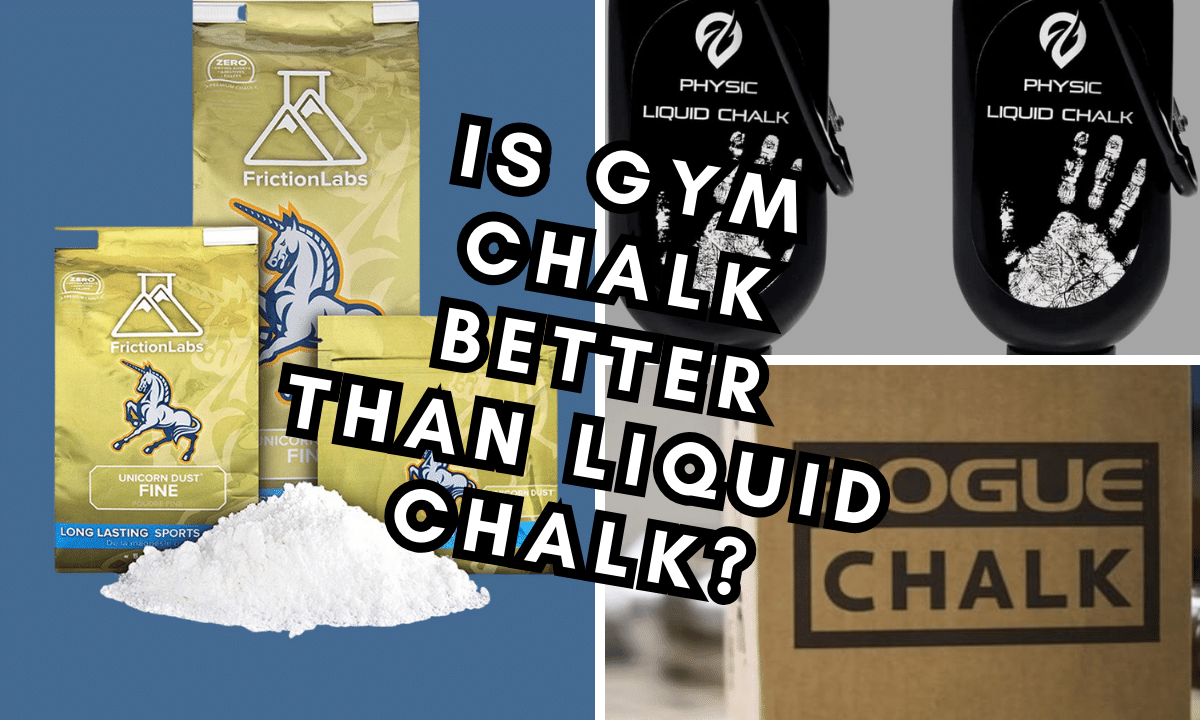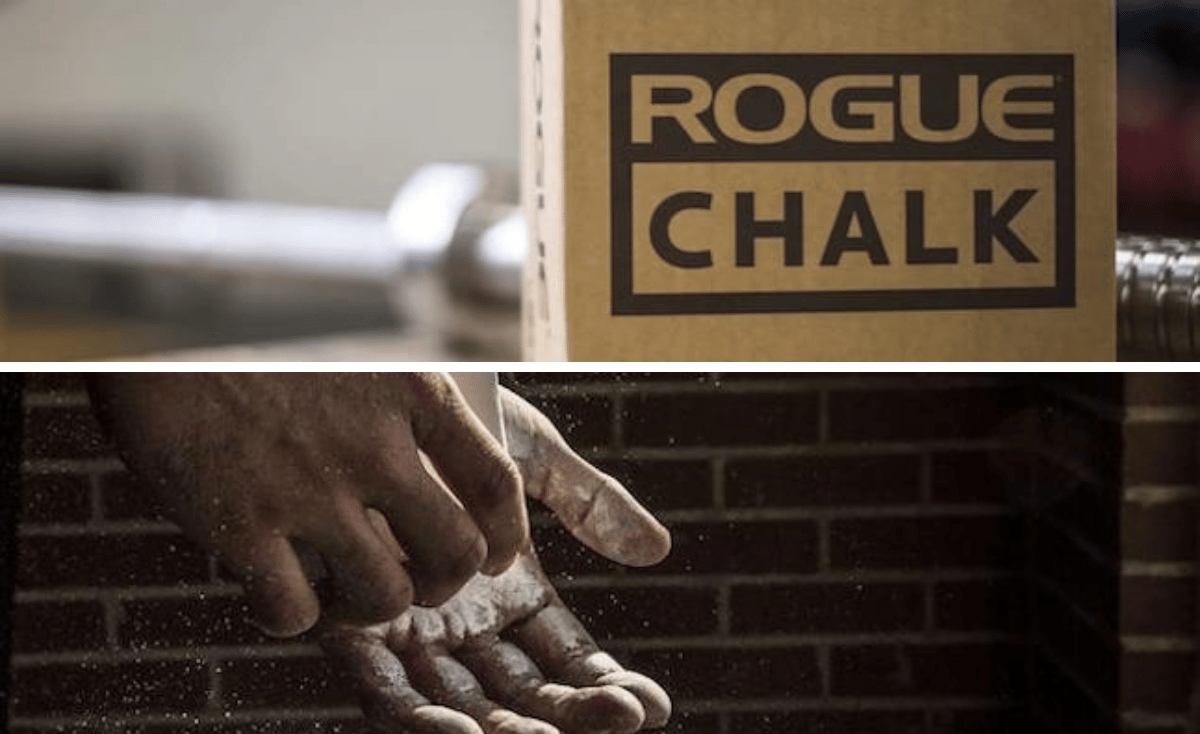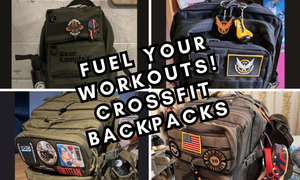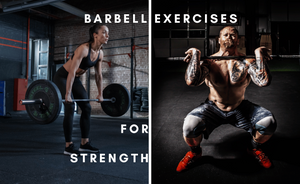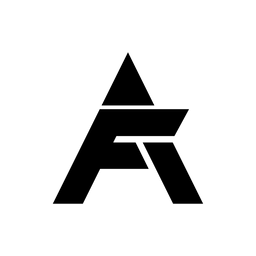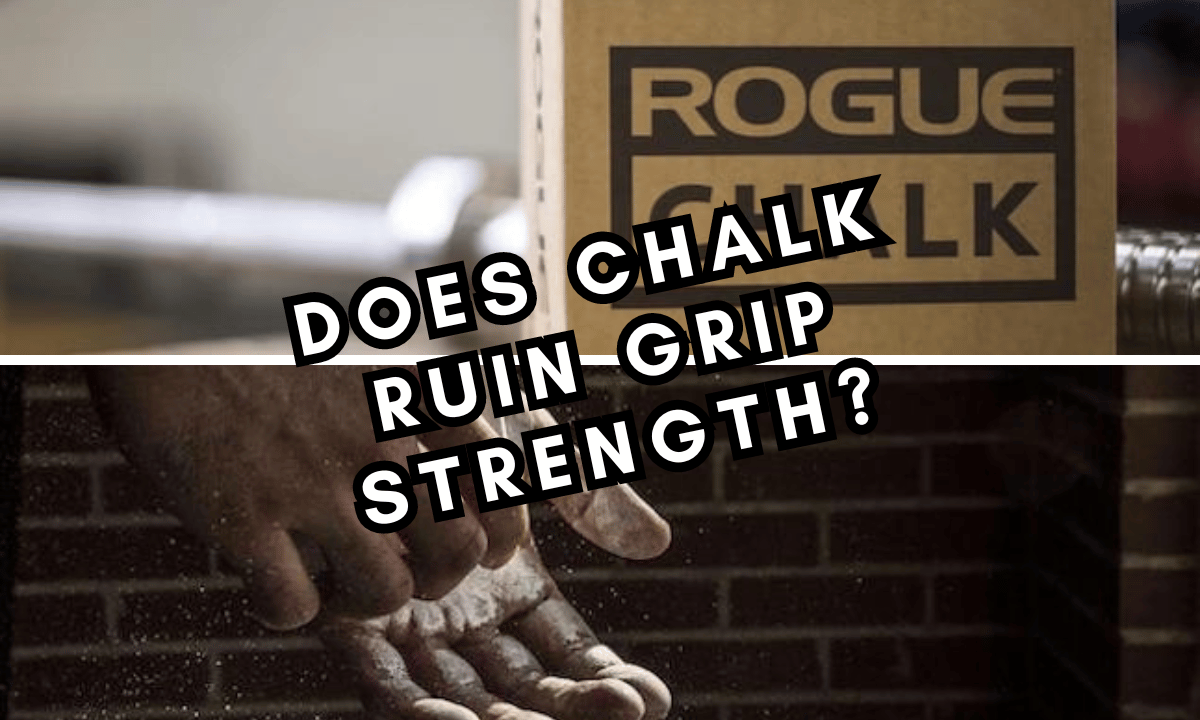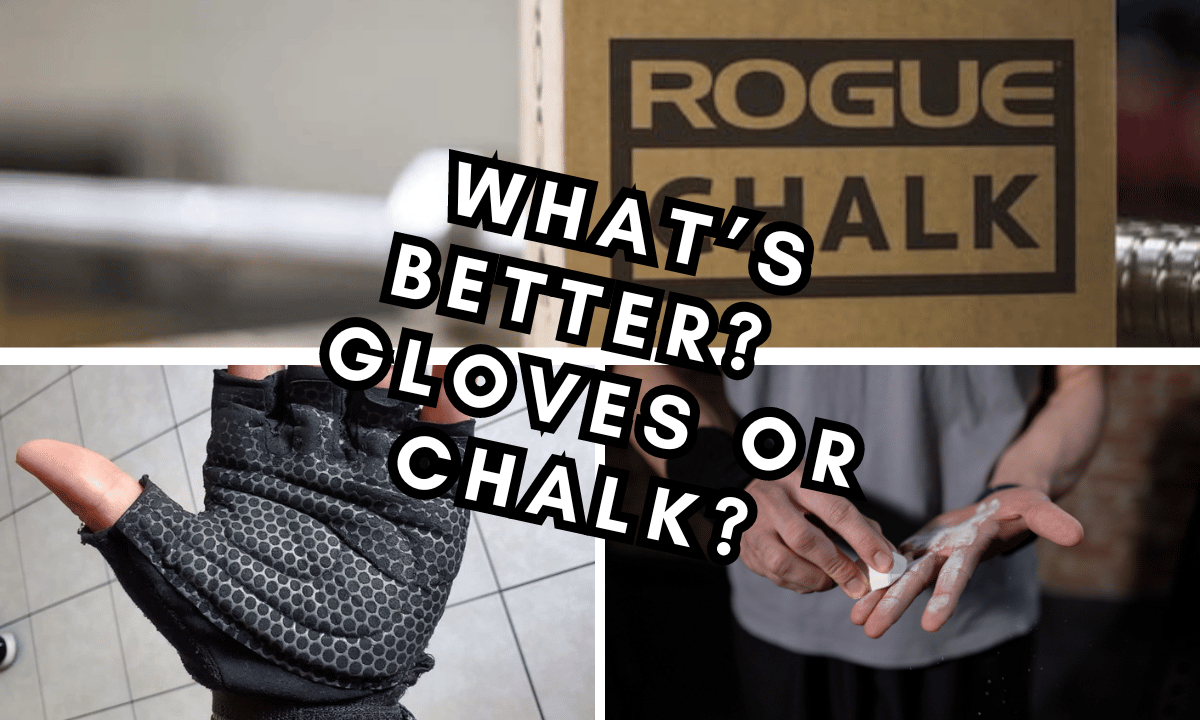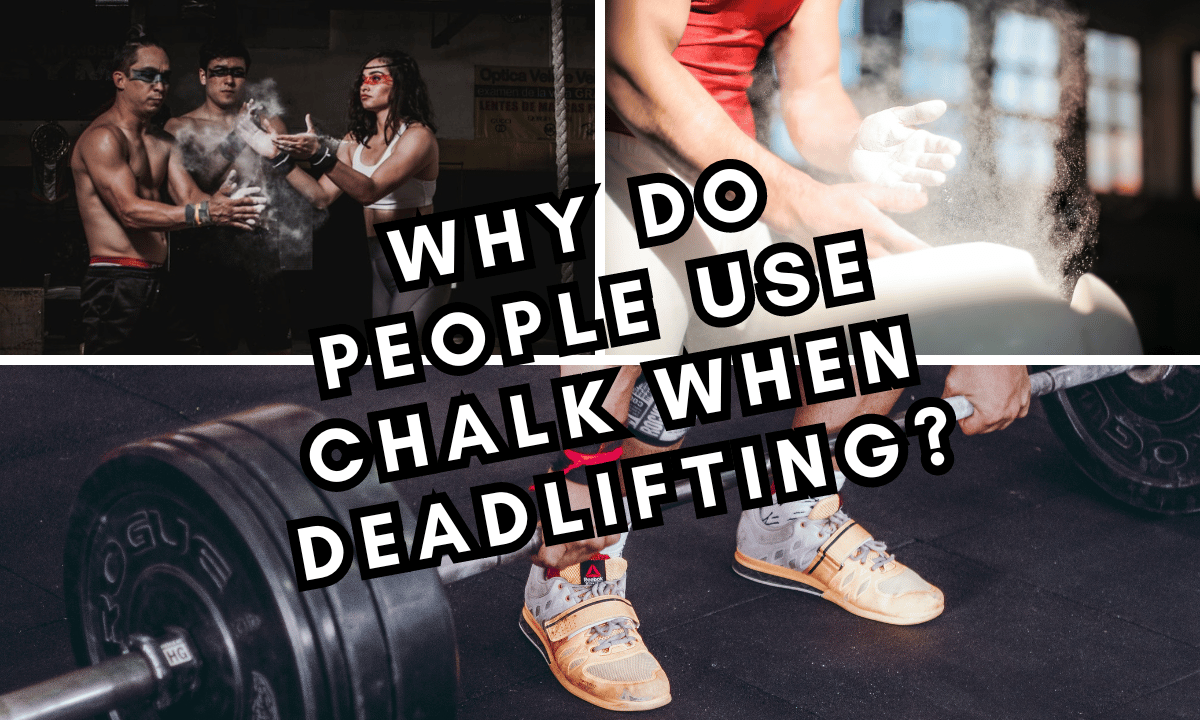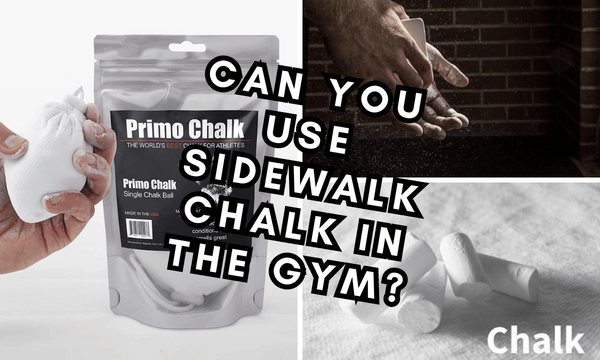Gym chalk is a seemingly simple yet versatile tool that can make a world of difference in various activities, including powerlifting, rock climbing, and gymnastics. By improving grip and preventing injuries, gym chalk has become an essential aid for athletes and fitness enthusiasts alike.
In this blog post, we’ll explore the different types of gym chalk, how to recognize “when should I start using gym chalk,” proper application techniques, gym chalk etiquette, and its benefits across different activities.
Key Takeaways
- Gym chalk is an essential tool for weightlifters, providing friction and a secure grip to reduce slippage.
- Different types of gym chalk offer varying levels of convenience and effectiveness. Choose the one that best suits your needs.
- Gym chalk can also be used for other activities such as powerlifting, rock climbing and gymnastics. Respect rules/etiquette when using in different environments.
Recognizing the Need for Gym Chalk
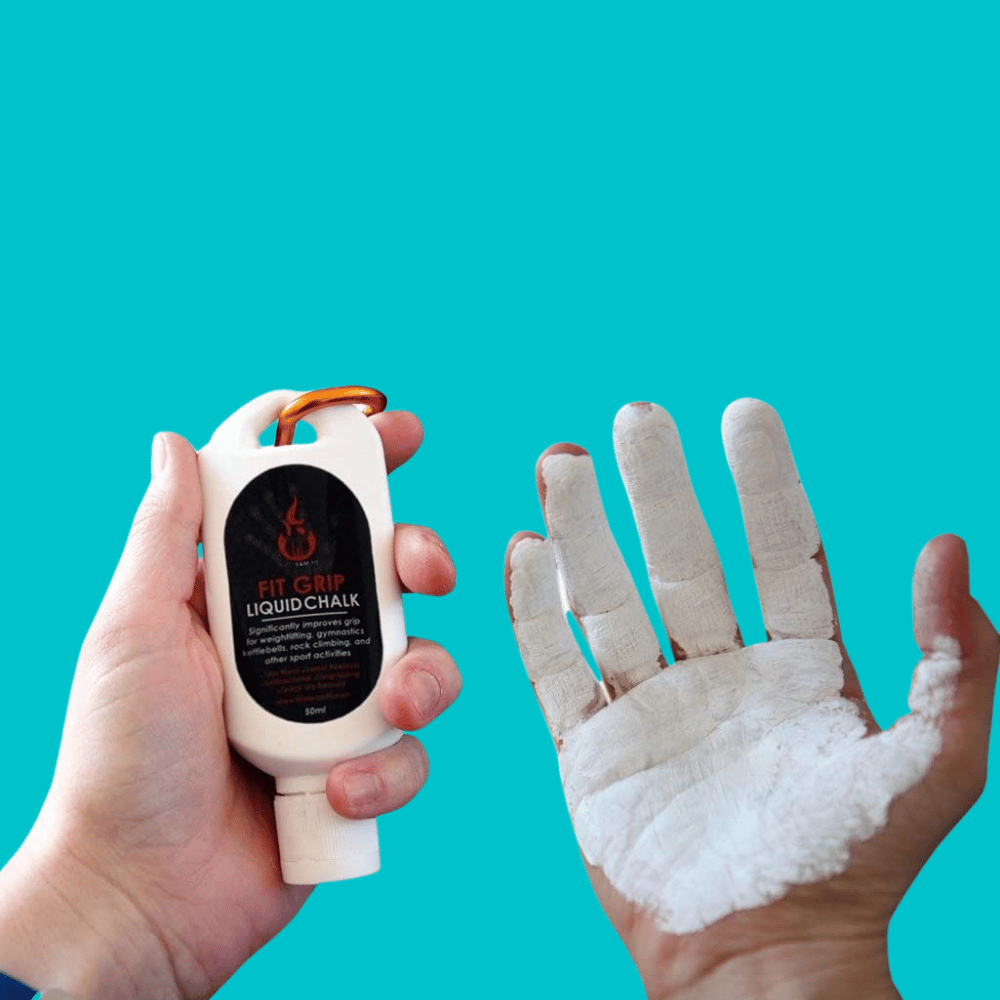
There are a few telltale signs that signal the need for gym chalk during your training sessions. Sweaty palms, slipping grip, and engaging in heavy lifts are common indications that gym chalk can come to your rescue.
Magnesium carbonate, the primary component of gym chalk, provides the following benefits:
- Absorbs sweat
- Provides friction
- Ensures a secure grip
- Prevents injuries
By using gym chalk, you can substantially enhance both your performance and safety.
Sweaty Palms
Sweaty palms can be an annoying obstacle during weight lifting. Excess moisture on your hands can hinder your grip on the barbell, making it more difficult to maintain the correct form and technique.
Gym chalk, such as Garage Strength lifting chalk, can absorb moisture, providing a more secure grip. To apply chalk effectively, ensure that your hands are thoroughly coated with chalk, including the areas between the fingers and the thumb.
Chalk balls, small sacks filled with crushed chalk, are particularly useful for weightlifters who want to lift safely with sweaty hands. The mess-minimizing design of chalk balls reduces the amount of dust that disperses into the air and onto the floor.
However, they may not provide the same level of coverage as block or liquid chalk. When using gym chalk to combat sweaty palms, it’s important to reapply it frequently and keep it clean and properly stored.
Slipping Grip
A slipping grip during weight lifting can be dangerous and hinder your progress. It can result in a decrease in stability and control, making it more difficult to maintain the correct form and technique.
Moreover, a slipping grip can restrict the amount of weight you can lift, as it may be difficult to maintain a secure hold on the bar or dumbbell.
Gym chalk comes to the rescue again by:
- Absorbing moisture
- Reducing friction between the bar and hand
- Ensuring a stronger grip
- Providing a safer lifting experience
Friction plays a crucial role in creating a secure grip during weight lifting. It enables the interaction between the object’s surface and the gripping surface, resulting in resistance to relative motion.
This resistance, provided by friction, helps to avoid slipping and increases the stability and control of the grip.
Heavy Lifts
Gym chalk is especially beneficial during heavy lifts, as it helps maintain a strong grip and prevent injuries. It is advisable for weightlifters to apply gym chalk before almost every lift to ensure the bar does not slip during the motion.
Utilizing gym chalk can improve grip strength, allowing for heavier weight to be lifted. Some exercises that may benefit from the use of gym chalk include:
- Heavy pulling movements
- Rows
- Olympic lifts
- Chin-ups
- Pull-ups
Using gym chalk can enhance your performance and help you achieve your fitness goals.
With the secure grip and reduced slippage gym chalk offers during heavy lifts, your performance can be greatly improved and your confidence boosted. Whether you’re a professional athlete or a fitness enthusiast, incorporating gym chalk into your routine can be a game-changer.
Types of Gym Chalk: Choosing the Right One for You
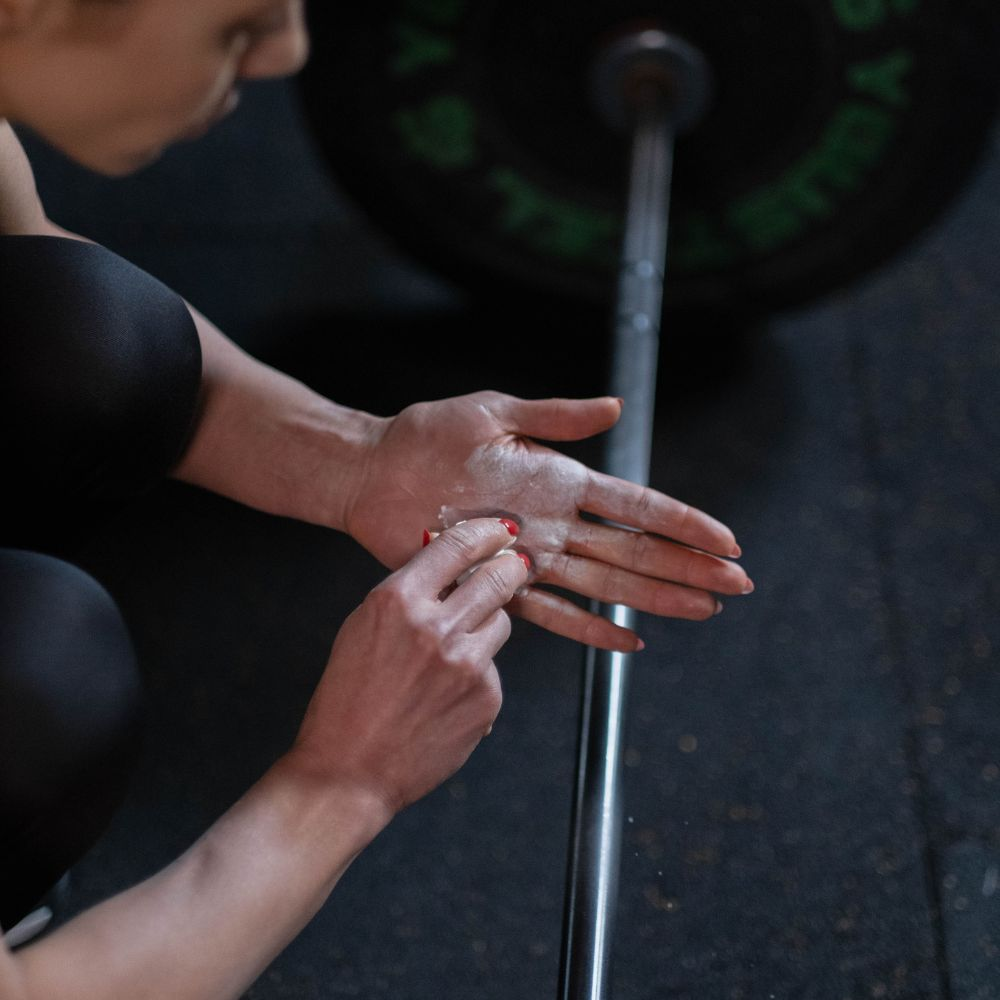
Gym chalk comes in various forms, each with its own advantages and disadvantages. The most common types include loose chalk, block chalk, and liquid chalk. Choosing the right gym chalk depends on personal preference and gym rules.
This section delves into the characteristics of each type, aiding you in making an informed decision about which one best suits your needs.
Loose Chalk
Block chalk often gets crushed into a powder, which is known as loose chalk. This type of chalk is favored because it is simple to apply. However, it can be messy to use and may not be allowed in some gyms due to the dust it creates.
To minimize mess, you can use a refillable chalk ball or bag with loose chalk. The Bryo Refillable Chalk Sock, for example, is a tool designed for transporting and applying loose powder chalk.
The sock comes with a supplementary chalk bag to contain the ball, providing additional protection against mess.
While loose chalk is a traditional and straightforward choice for gym chalk users, it’s crucial to bear in mind the potential mess it can create. If you’re concerned about dust and cleanliness, consider trying other forms of gym chalk, like block chalk or liquid chalk.
Block Chalk
Block chalk is a compressed form of loose chalk that is less prone to messiness and can be applied directly to the hands without any hassle. Simply rub the block over the areas of your hands that will come into contact with the barbell for a secure grip.
However, block chalk can create a dust dispersal issue, leading to increased cleaning requirements and possible respiratory irritation. Transporting block chalk can also be difficult due to its bulkier size and may result in a mess inside a gym bag if it spills.
Many gyms don’t allow athletes to use block chalk while working out due its tendency to create mess. As a result, it has become less popular among fitness enthusiasts..
Block chalk offers a less messy substitute for loose chalk, but potential drawbacks should be taken into consideration. If you’re looking for a cleaner option, liquid chalk might be a better choice for you, and you can store it in a chalk bucket.
Liquid Chalk
Liquid chalk is a form of magnesium carbonate in liquid form that contains alcohol and dries quickly. It is a convenient and clean option, making it suitable for use in commercial gyms where traditional chalk is not allowed. However, liquid chalk has some drawbacks:
- It is typically more costly than other types of chalk.
- It has a shorter lifespan.
- It dries out the skin to a greater degree than other types, which may be a concern for individuals with dry or sensitive skin.
- Certain athletes find the grip offered by liquid chalk to be less efficient than block chalk.
While liquid chalk presents a tidier alternative to traditional gym chalk, its effectiveness and longevity might not measure up to other forms. Experiment with different types of gym chalk to find the one that works best for you and your workout routine.
Proper Application of Gym Chalk
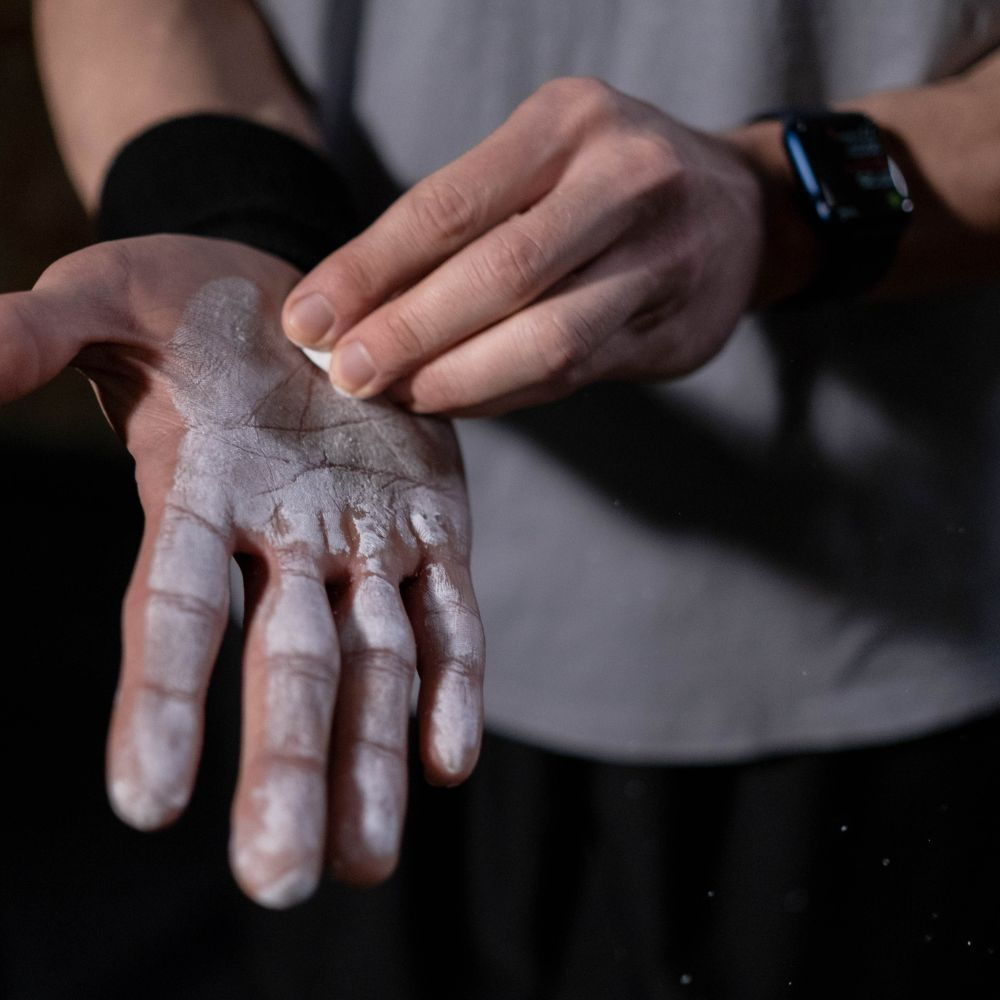
To get the most out of your gym chalk, it’s important to know how to apply it properly. Proper application involves covering the necessary areas of your hands, applying it as needed during your workouts, and storing it in a clean and accessible manner.
We’ll examine these steps in detail to ensure effective use of your gym chalk.
Hand Coverage
Hand coverage should focus on the areas of your hands that come into contact with the barbell, ensuring a secure grip. For optimal grip, lightly drag a block of chalk on each finger from top to bottom, followed by across the palm. This action helps absorb sweat and improve grip. It is also important to cover the following areas:
- fingertips
- fingernails
- under fingernails
- between fingers
- thumb area
This ensures full coverage and a secure grip.
Thoroughly coating your hands with gym chalk can substantially enhance your grip and performance during a variety of activities. Remember, proper hand coverage is key to getting the most out of your gym chalk.
Frequency of Application
The frequency of gym chalk application depends on your individual needs and the intensity of your workout. Changes in skin roughness and elasticity, the need for improved grip, the type of exercise being performed, and the level of hand sweatiness are factors that influence the frequency of gym chalk application.
It is advised to reapply chalk when your hands start to feel slippery or lack grip. For strenuous workouts, applying gym chalk prior to each set is recommended.
Applying gym chalk when necessary during your workout helps maintain a solid grip and avoids slippage. Keep in mind that the frequency of application may vary depending on your specific needs and the intensity of your workout.
Storage and Cleanliness
Storing gym chalk:
- Use a clean, dry container or bag to prevent contamination and mess
- Tupperware containers, ziplock bags, and chalk buckets are all suitable options
- Liquid chalk is a popular choice for a mess-free solution
- Keep gym chalk in a dry and airtight container
- Store it in a cool, dry place to maximize its longevity
Maintaining cleanliness is also crucial when using gym chalk. Here are some tips to keep your gym chalk clean and effective:
- Wipe down mats and equipment regularly to remove chalk residue.
- Clean up any excess chalk after use.
- Properly store your gym chalk to prevent it from getting dirty or contaminated.
By following these tips, you can ensure that your gym chalk stays effective and ready for use throughout your workouts.
Gym Chalk Etiquette and Rules
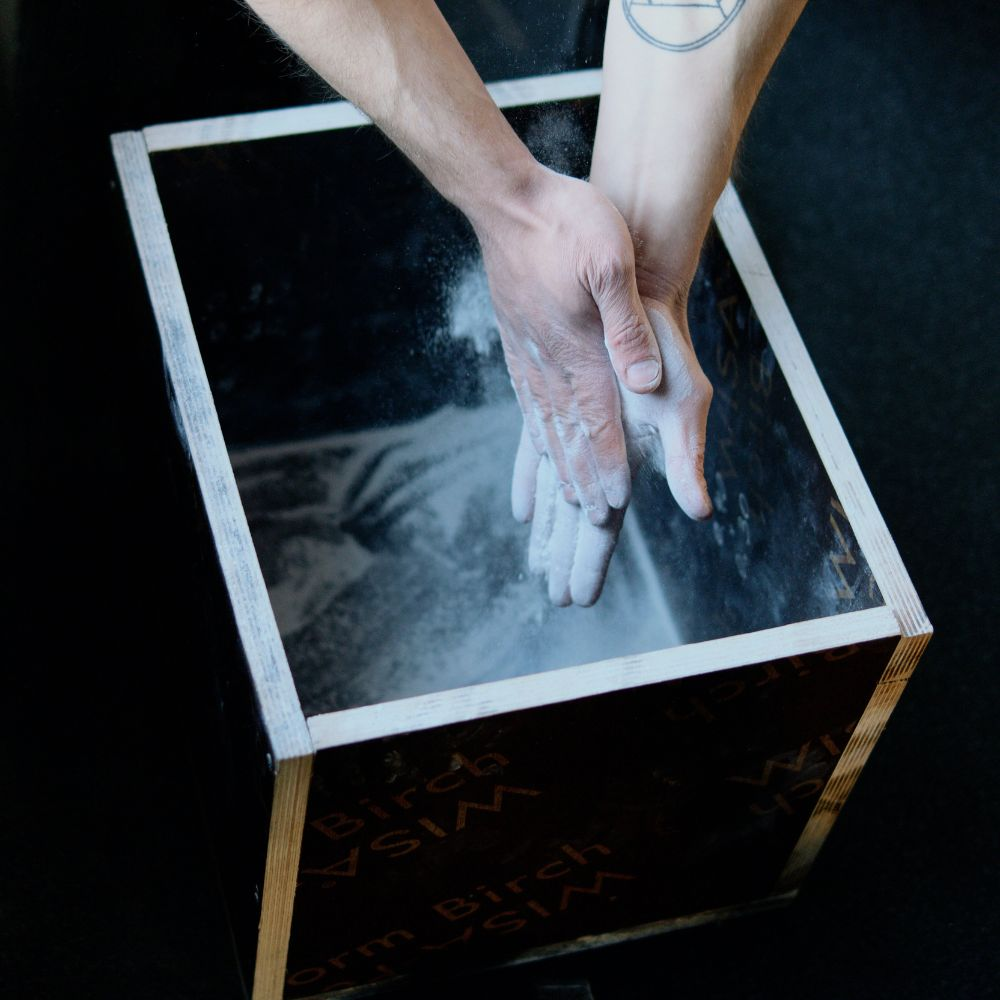
Gym chalk etiquette and rules vary depending on the gym environment you’re in. Commercial gyms often have stricter regulations than independent or home gyms, but it’s important to respect the rules and fellow gym-goers no matter where you work out.
This section discusses the etiquette and rules around gym chalk usage in commercial gyms, independent gyms, and home gyms.
Commercial Gyms
Commercial gyms may ban gym chalk due to concerns about mess and potential respiratory issues. In these cases, liquid chalk is a more suitable option, as it is less messy and causes fewer respiratory problems due to the reduced amount of dust it produces.
Togear Liquid Chalk, for example, is an easy-to-use and transportable option for those seeking a mess-free alternative to traditional chalk.
If you choose to use gym chalk in a commercial gym, be sure to adhere to the gym’s specific policies regarding chalk usage. Clean up any mess you create and be mindful of other gym-goers who may be sensitive to chalk dust.
Independent Gyms
Independent gyms, particularly those dedicated to powerlifting or Olympic lifting, may be more lenient with gym chalk usage. However, it’s still important to clean up any mess and respect fellow gym-goers.
Be sure to use only the necessary amount of chalk to secure a firm grip on the bar and avoid creating excess mess. If you’re unsure about the gym’s specific rules and etiquette, consult the gym administration or staff to learn more.
Adhering to gym chalk etiquette in independent gyms promotes a positive experience for all, while still allowing you to enjoy the benefits of gym chalk during your workouts.
Home Gyms
Home gyms offer the most freedom for gym chalk usage, but maintaining cleanliness and proper storage is still essential. Use gym chalk sparingly and only when necessary to improve grip and prevent slipping. Chalking up for every rep or set should not be necessary. In the event of any chalk spillage, ensure to clean it up promptly.
Maintaining cleanliness and proper storage in your home gym not only maximizes the benefits of using gym chalk but also keeps your workout space neat and safe.
Gym Chalk for Different Activities

Gym chalk isn’t only for weightlifters. Various activities can benefit from the use of gym chalk, such as powerlifting, rock climbing, and gymnastics.
This section delves into how gym chalk can enhance grip and prevent injuries for athletes in various disciplines.
Powerlifting
Powerlifters can greatly benefit from gym chalk during heavy lifts and competitions, ensuring a secure grip and preventing bar slippage. Some popular choices for powerlifters include:
- Rogue Gym Chalk: made with pure magnesium carbonate and provides excellent grip and moisture absorption
- Liquid Grip: a liquid chalk alternative that dries quickly and provides a long-lasting grip
- Primo Chalk: made with high-quality magnesium carbonate and offers a smooth and reliable grip
Using weightlifting chalk, also known as gym chalk, during powerlifting sessions enables you to lift heavier weights confidently, assured of a secure and stable grip.
Whether you’re preparing for a competition or simply want to improve your grip during strength training sessions, incorporating gym chalk into your powerlifting routine can make a significant difference in your performance.
Rock Climbing
Rock climbers rely heavily on gym chalk for a reliable grip during climbs. As the sport demands a strong hold on various surfaces, gym chalk is essential for providing the necessary friction and moisture absorption. Popular options for rock climbers include:
- Metolius Super Chalk
- Unicorn Dust
- Black Diamond White Gold
- Mammut liquid chalk
Integrating gym chalk into your rock climbing routine allows you to tackle challenging climbs confidently, secure in the knowledge that your grip is firm and your hands are safeguarded from slipping.
Gymnastics
Gymnasts use gym chalk for a secure grip during dynamic movements and performances, applying it to hands, wrists, and forearms. Gym chalk helps gymnasts maintain a secure grip during their routines, preventing injuries and allowing them to perform at their best.
Gymnasts typically use loose chalk to improve their grip and reduce friction on their hands, feet, and legs.
Whether you’re a seasoned professional or a novice gymnast honing your skills, integrating gym chalk into your routine can improve your grip, minimize injuries, and ultimately heighten your performance.
Summary
In conclusion, gym chalk is a versatile tool that can greatly enhance your performance and safety during various activities. By recognizing the need for gym chalk, choosing the right type for your needs, and applying it correctly, you can ensure a secure grip and prevent injuries.
With proper gym chalk etiquette and usage, you can confidently tackle challenging workouts and achieve your fitness goals. So, don’t let sweaty palms or slipping grip hold you back – give gym chalk a try and experience the difference it can make in your training.
Frequently Asked Questions
When should you use lifting chalk?
When doing heavy lifts such as deadlifts or chin ups, using chalk can help you increase your grip strength and power to the next level. Many gyms even provide their members with chalk these days.
Should I use chalk for pull ups?
Chalk helps create friction between your skin and the weight, making it a great tool for exercises like pull ups. It dries slick hands and can help you better hold on to the bar during pull ups. Therefore, using chalk for pull ups is recommended.
Is gym chalk safe for kids?
It is generally safe for kids to use chalk, as long as it is not inhaled in large amounts over a prolonged period of time.
Can you use chalk in Anytime Fitness?
It is permissible to use liquid chalk in Anytime Fitness clubs; however, weights must be returned after use.
Can gym chalk be used for activities other than weightlifting?
Yes, gym chalk can be used for activities other than weightlifting, such as powerlifting, rock climbing and gymnastics, as it enhances grip and helps prevent injuries.
